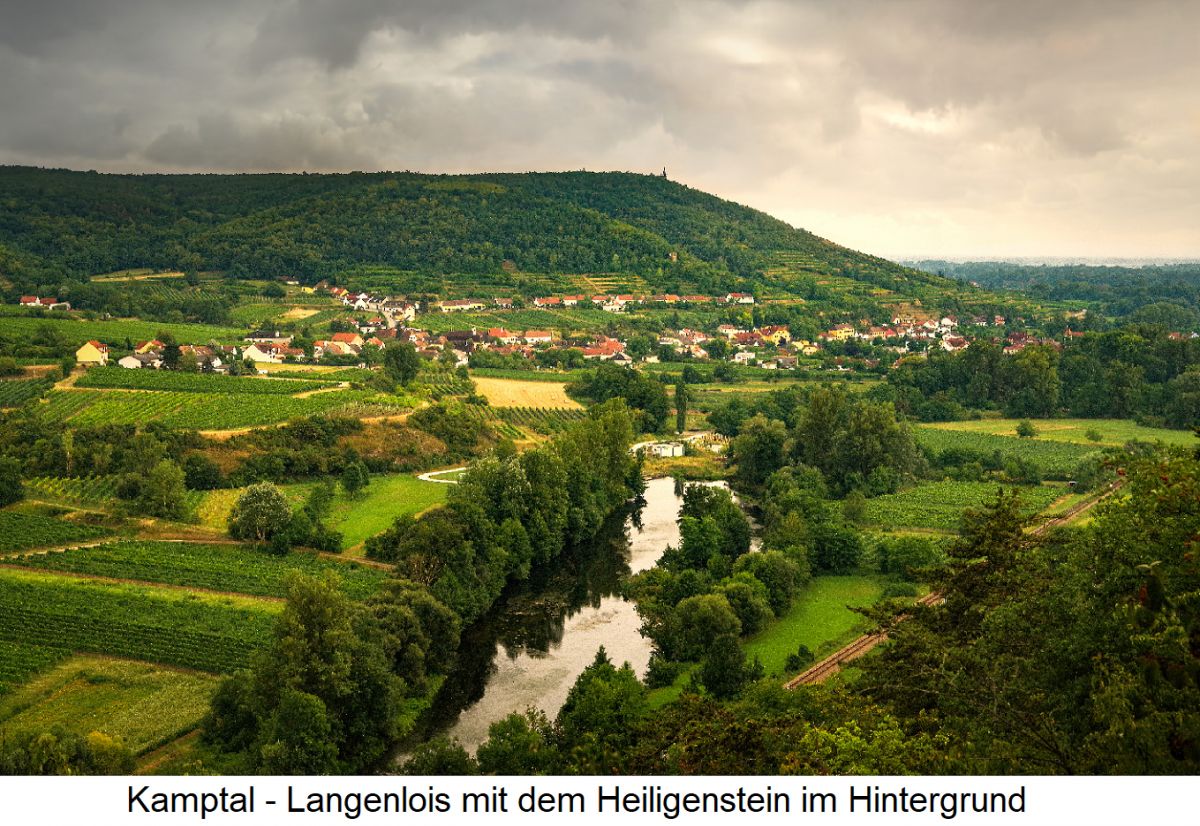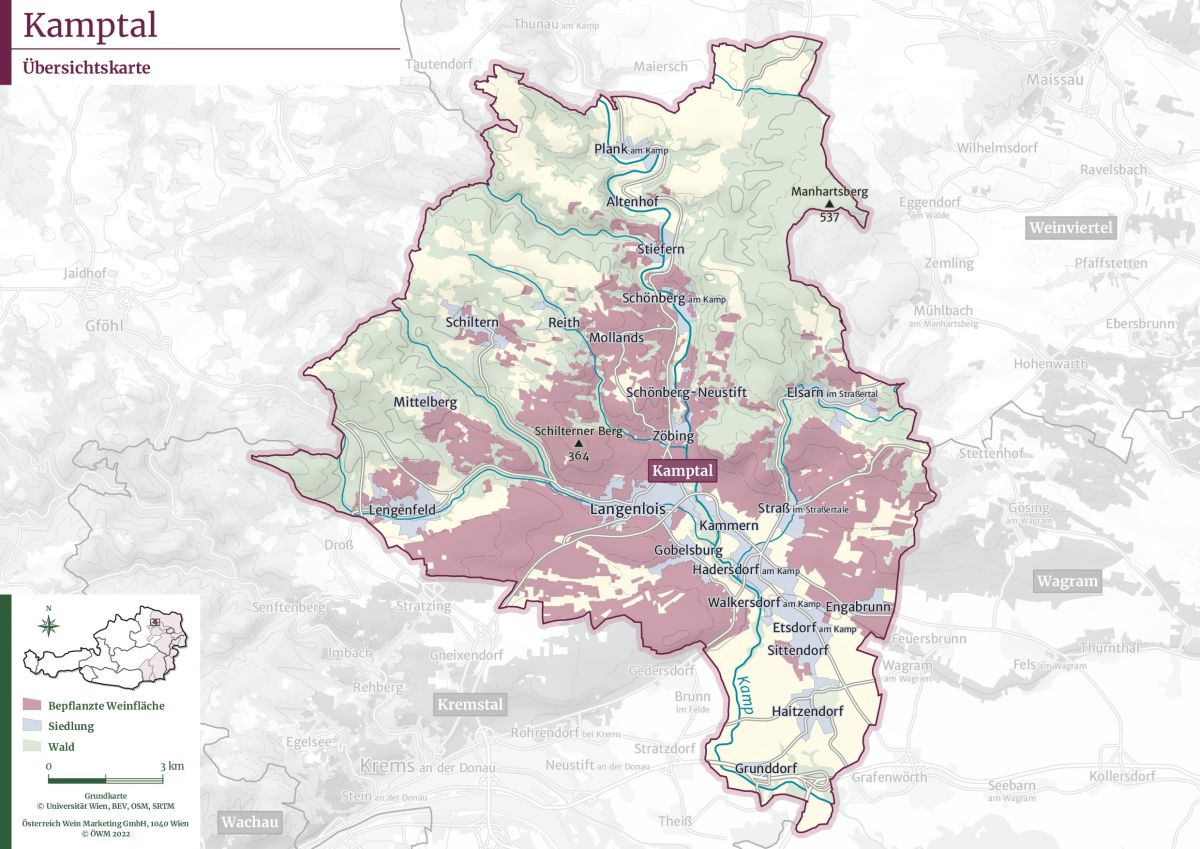One of the eight specific wine-growing regions in the Austrian federal state or generic wine-growing region of Lower Austria. The name was given to the area west of Vienna by the 153 kilometre long Kamp river, which flows through it from Schönberg in the north to Hadersdorf in the south and flows into the Danube near Krems. There is evidence of viticulture here since at least the early Middle Ages. Until 1993, the two now independent wine-growing regions of Kamptal and Kremstal were united under the name Kamptal-Donauland.

Climate & soils
The predominant soil types are loam, loess, gravel and primary rock soils. The climate is characterised by hot, Pannonian influences and cool currents from the Waldviertel. The amount of precipitation is rather low; there is often fog in spring, autumn and winter. A special feature is the famous Heiligenstein near Zöbing-Langenlois, made of desert sandstone with volcanic elements, whose name refers to the "hellish" solar radiation (exposure) with a hot, dry microclimate. The alternation between hot days and cool nights gives the wines lively acidity.
Wine-growing communities
The wine-growing centre of the Kamptal wine-growing region is the largest Austrian wine-growing municipality in terms of vineyard area, Langenlois, with the cadastral municipalities of Gobelsburg, Haindorf and Zöbing. Other municipalities are Etsdorf, Hadersdorf, Kammern, Lengenfeld, Schönberg, Sittendorf, Straß im Straßertale and Walkersdorf. The best-known vineyard is the above-mentioned Zöbinger Heiligenstein; others are Bleckenweg, Gaisberg, Grub, Dechant, Fahnberg, Fraupoint, Hasel, Hiesberg, Käferberg, Kalvarienberg, Kogelberg, Ladner, Lamm, Letten, Loiserberg, Liß, Panzaun, Sauberg, Schenkenbichl, Seeberg, Spiegel, Sonnwendberg, Stangl, Steinhaus, Steinmassl, Tagler and Wechselberg.

Grape variety index
In 2022, the vineyards covered a total of 3,574 hectares of vines. Compared to 2015 with 3,907 hectares, this was a reduction of 333 hectares (8.5%). The proportion of red wine varieties is 19%, the proportion of white wine varieties 81%. It dominates undisputedly with over half of the stock Grüner Veltliner, followed by Zweigelt, Riesling and Müller-Thurgau.
Grape variety
|
in Austria
|
colour |
HA
|
%
|
HA
|
%
|
| Grüner Veltliner | White plum | white | 1.965 | 55,0 | 1.982 | 50,7 |
| Zweigelt | Blauer Zweigelt, Rotburger | red | 456 | 12,8 | 520 | 13,3 |
| White Riesling | Riesling Rhine Riesling | white | 361 | 10,1 | 397 | 10,2 |
| Müller-Thurgau | Rivaner | white | 149 | 4,1 | 243 | 6,2 |
| Chardonnay | Morillon - not used in Lower Austria | white | 97 | 2,4 | 87 | 2,2 |
| Pinot Blanc | Pinot Blanc, Klevner | white | 79 | 2,2 | 85 | 2,2 |
| Muscat | Yellow M., Red M. / Muscat Blanc | white | 72 | 2,0 | 50 | 1,3 |
| Frühroter Veltliner | Malvasia | white | 45 | 1,3 | 60 | 1,5 |
| Sauvignon Blanc | Muscat Sylvaner | white | 45 | 1,4 | 45 | 1,1 |
| Pinot Noir | Pinot Noir, Pinot Noir | red | 40 | 1,1 | 44 | 1,1 |
| Welschriesling | - | white | 37 | 1,0 | 53 | 1,4 |
| Blue Burgundy | - | red | 32 | 0,9 | 58 | 1,5 |
| St Laurent | - | red | 28 | 0,8 | 41 | 1,0 |
| Blauer Portugieser | - | red | 25 | 0,7 | 70 | 1,8 |
| Cabernet Sauvignon | - | red | 17 | 0,5 | 15,6 | 0,4 |
| Merlot | - | red | 17 | 0,5 | 15,3 | 0,4 |
| Roter Veltliner | - | white | 13 | 0,4 | 22 | 0,6 |
| Roesler | - | red | 11 | 0,3 | 15,7 | 0,4 |
| Neuburger | - | white | 10 | 0,3 | 23,4 | 0,6 |
| Grey Burgundy | Pinot Gris, Ruländer | white | 10 | 0,3 | 9,1 | 0,2 |
| Traminer | Gewürztraminer, Roter T., Gelber T. | white | 7 | 0,2 | 7,2 | 0,2 |
| Blossom muscatel | - | white | 6 | 0,2 | - | - |
| Muscat Ottonel | - | white | 6 | 0,2 | 6,5 | 0,2 |
| Scheurebe | Seedling 88 | white | 4 | 0,1 | 4,5 | 0,1 |
| Cabernet Franc | - | red | 4 | 0,1 | 3,7 | 0,1 |
| Blaufränkisch | - | red | 3 | 0,1 | 3,0 | 0,1 |
| Syrah | Shiraz | red | 3 | 0,1 | 2,2 | 0,1 |
| Muscaris | - | white | 2,3 | 0,1 | - | - |
| Sylvaner | Green Sylvaner | white | 2 | 0,1 | 3,4 | 0,1 |
| Bouvier | - | white | 1,5 | - | 2,7 | 0,1 |
| Souvignier Gris | - | white | 1,4 | - | - | - |
| Gold burger | - | white | 0,6 | - | 0,7 | - |
| Rose muscatel | - | red | 0,5 | - | - | - |
| Furmint | - | white | 0,2 | - | - | - |
| Gold muscatel | - | white | 0,1 | - | - | - |
| Zierfandler | Late red | white | 0,1 | - | 1,8 | - |
| Rotgipfler | - | white | 0,1 | - | 1,4 | - |
| Jubilee vine | - | white | 0,1 | - | 0,2 | - |
| Blauer Wildbacher | - | red | 0,1 | - | - | - |
| Rathay | - | red | 0,1 | - | - | - |
| other varieties | white/red | 39 | 0,8 | 5,9 | - | |
WHITE VARIETIES |
|
white |
2.930 |
81 |
3.108 |
80 |
RED VARIETIES |
|
red |
644 |
19 |
799 |
20 |
TOTAL |
|
|
3.574 |
|
3.907 |
|
DAC system
The origin-controlled Kamptal DAC quality level was introduced from the 2008 vintage. All other quality wines must be marketed with the origin Lower Austria, the regional wines under the wine-growing region designation Weinland. In addition to the generally applicable DAC conditions, special rules apply.
The quality wine grape varieties Grüner Veltliner and Riesling are authorised. The wines must be vinified dry. From the 2016 vintage, a three-tier system was introduced to emphasise the origin more strongly. There are lower limits for the alcohol content, but no upper limits compared to before. The date for the application to obtain the state inspection number is staggered. If the decision is favourable (usually within one week), the wine may be marketed:
- Kamptal DAC, zum. 11.5% vol; 1 January
- Kamptal DAC with indication of place; as of 12% vol; 1 January
- Kamptal DAC with indication of place and vineyard (indication "Ried" and vineyard name); at 12.5% vol; 1 March
- Kamptal DAC Reserve; 13% vol; 1 July
The wines must have a characteristic flavour typical of the two grape varieties. For the variety Grüner Veltlinerfruity, delicately spicy, no botrytis note, no noticeable woody note(toast flavour), balanced, not high in alcohol. For the variety Riesling: fragrantaromatic, elegant, mineral, no botrytis dominance, no woody flavour, balanced, not alcoholic. For the Reserve quality level: strong style, pronounced regional and varietal flavours, dense and long finish, a delicate (filigree) botrytis and wood note is permitted.
Producers
Well-known wineries are Aichinger Josef, Allram, Angerer Kurt, Arndorfer, Auer Leopold, Brandl Günther, Bründlmayer Willi, Cobaneshof Schneider, Deim Alfred Markus, Dolle Peter, Ehn Ludwig, Eichinger Birgit, Grillmaier, Groll Wolfgang, Hager Matthias, Hager Oskar, Hiedler Ludwig, Hirsch Johannes, Höfinger Egmont, Jurtschitsch, Kemetner Leopold, Kirchmayr Andreas (now disbanded), Laurenz V., Leindl (formerly Burgi Eder), Leithner Thomas, Loimer Fred, Nastl Günter, Rabl Rudolf, Retzl Erwin, Sax Rudolf, Schloss Gobelsburg, Schreibeis, Steininger Karl, Summerer, Topf Johann, Vinokus, Waldschütz Anton, Waldschütz Reinhard, Weixelbaum Heinz, Zottlöderer. Associations are Kamptal Klassik and Traditionsweingüter Österreich.
Pictures: © ÖWM Marcus Wiesner
Voices of our members

Serious sources on the internet are rare - and Wine lexicon from wein.plus is one such source. When researching for my articles, I regularly consult the wein.plus encyclopaedia. There I get reliable and detailed information.
Thomas Götz
Weinberater, Weinblogger und Journalist; Schwendi